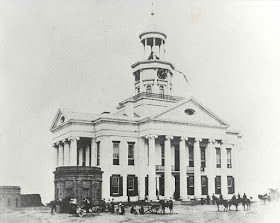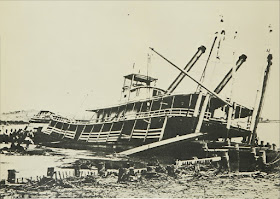Ulysses Grant(above) had tried to avoid the Mississippi River. In November of 1862 he made his first attempt to capture Vicksburg high and dry 200 miles inland from the Big Muddy. The Tennessee and the Cumberland rivers had solid ground on either bank, offering highways to out flank the rebels and support an advance all the way to Oxford, Mississippi. But then had come the raid at Holly Springs, forcing Grant to retreat 80 miles. And then in Memphis, Tennessee, the rival McClernand appeared. To control him Grant was forced to return to the river and solve the Gordian Knot of its meanders.
The first thousand miles of the Upper Mississippi River above Cairo, Illinois was the barely mature child of glaciers, still reasonably straight and clear in its intent. But the thousand miles of the Lower Mississippi, especially the delta, was the Old Man River, "meandering through sub-tropical swamps and forests..." at the center of a 100 mile wide flood plain, scattered with the detritus of forgotten inundations and abandoned alluvial choices. About midway in that thousand mile corkscrews, where high bluffs touched the river's banks on both shores, was Vicksburg, Mississippi.
As if tying a shoestring, 460 miles above New Orleans, at the Eagle Loop, the river twisted north, coming to within 30 yards of cutting its own "Terrapin Neck".
The Big Muddy came out of this constriction flowing south again, the faster currents carving a graceful 6 mile long arch of Millikin's bend on the western shore. Five miles south the river widened slightly, dropping sediments close to the Louisiana bank, forming the mile long Paw Paw Island, named after small fruit trees which grew in abundance there. The river then made a slight right westward bend, opposite Duckport landing. Just south of Duckport, on the eastern shore, was the mouth of the Yazoo River. Then at the left hand Tucsumbia Bend the Mississippi gathered its strength for a tight 180 degree bend as it...
...squeezed between the encroaching 125 foot high limestone and shale bluffs of the start of the Walnut Hills on the east and the western 80 foot high pinnacle on the Desotto peninsula.
Staring down at the apex of that hairpin corner from 80 feet above the eastern river bank, where any Yankee boats heading northward or south would have to slow to make the turn, was the first of Vicksburg's immediate defenses, the Water Battery - three 32 pound rifled cannons, a single smooth bore 32 pound cannon and one 10 inch cast iron Colombiad cannon. The latter could throw a 128 pound shell 4,000 yards, or a solid shot cannon ball 5,600 yards, making it particularly useful against even ironclad warships at this narrow range.
Behind the Water Battery and 25 feet higher, was Fort Hill. It offered an even more imposing view of the bend, and provided plunging fire from three 10 inch and one 8 inch Columbiads, a 32 pound rifled cannon, and two breach loading English built rifled cannons firing 12 pound shells, a 3 inch Armstrong and a 2.7 inch Whitworth. Rifled cannon were more accurate over a longer range, but the grooved barrels also slowed re-loading.
Running for half a mile south from Fort Hill, along the Yazoo City Road, were 7 more river front batteries. By the winter of 1863 the city could boast a total of 37 heavy guns in 13 batteries, plus 13 mobile field artillery guns.
At the northern border of the town itself, The Glass Bayou cut a 45 degree angled ravine through the yellow packed Loess soil, crimping Vicksburg's most infamous neighborhood...
... the cramped crowded six square blocks of rundown boarding houses, bordellos, disreputable bars and gambling parlors, called the Kangaroo district (above). It had almost completely burned down in the 1830's, but its economic productivity defied morality and it was quickly rebuilt.
Along the waterfront were the long row of docks and commercial warehouses, divided 7 blocks south of the Glass Bayou by the Southern Railroad line's yard and depot. Vicksburg in 1860 was home to 4,500 souls in some 500 structures, drawn initially by the riverboat trade. It is difficult, 200 years later, to appreciate the value of steamboats to the Confederacy.
A wagon drawn by a 2 horse team might pull a ton over the appalling roads of Mississippi at a speed of perhaps 2 miles an hour or less, for maybe 20 miles on a good day. The latest technology, the steam locomotive, could pull up to 150 tons at 10 to 25 miles an hour, depending on the quality of the iron rails. But a side or stern paddle wheel steamboat could carry up to 1,700 tons of cotton or wheat, can goods or cattle at 4 miles an hour against the river's current.
The combination of these two steam technologies, rail and ship, was the reason for Vicksburg's value to the defenders of slavery.
There were 2 iron foundries in Vicksburg, making and repairing boilers and machinery, boat construction ways, lumber mills, a canning factory and a molasses refinery. Moving inland from the business districts were the residential neighborhoods, with each block away from the river climbing another step up the bluffs.
At the peak, 8 blocks and 80 feet above the river, were St. Paul's Catholic Church and the Warren County Courthouse (above). This "Gibraltar of the Confederacy", the most heavily defended town in the rebel south, had cast most of its votes in the 1860 Presidential election for the pro-slavery unionist Democrat, 39 year old Kentuckian John Cabell Breckinridge.
But whatever its resident's ambivalence toward the war, after 2 years of bloodshed they would suffer or triumph as rebels.
Three blocks south of the mouth of The Glass Bayou was an artillery battery near the Vicksburg Whig newspaper office - a 10 inch Columbiad and three 32 pound rifles. Near the railroad depot was a single 10 inch Columbiad (above).
And where the rail line turned inland was a third city battery, called, obviously enough, the Railroad Battery - a single 18 pound gun nicknamed "Whistling Dick" (above).
A quarter mile beyond the southern edge of the city, 2 miles south of Fort Hill, atop another high bluff and next to a charity hospital built for river sailors was the Marine Hospital Battery - Three smooth bore cannon throwing 42 pound shots, two 32 pound cannon and two 32 pound rifles.
Due west of the Vicksburg docks, across the 900 foot wide, 140 foot deep Mississippi River, was the ferry port on De Soto Point, (above) where the Louisiana and Texas railroad met the river from the west. The current midstream here was just one and one-half miles an hour.
The current was so slow because although the river still had 400 miles to go before it reached the Gulf of Mexico, it had just 47 feet of altitude to lose - one foot fall for every 9 1/2 miles south. This was the Old Man River, changing his mind as often as the weather. And although it was true that , "He don't say nothin'", it was also true, "He must know somethin'", and he would share that knowledge for a heavy price.
You may remember that in mid-May of 1862 Admiral Farragut's deep draft blue water fleet had steamed up the river to Vicksburg, and demanded it's surrender. But the Confederates had scoffed at the navy's big guns, confident the Yankees dare not stay for fear the ebbing river would strand their ships on its snags and sandbars. But Farragut was a sailor and he knew about tides and river fluctuations. And he had dispatched soldiers under a regular army general to simply force the river to submit to the Federal Government.
The Old Man River's new student was General Thomas R. Williams, a 39 year old Michigander - his father had been the first American Mayor of Detroit, At the end of June 1862, under direct orders from President Abraham Lincoln, Williams set 3,000 soldiers and half again as many freed slaves to digging a canal across the base of the Desoto Peninsula.
It seemed logical. The river wanted to get to the Gulf by the quickest route possible. A canal would bypass that hairpin turn, isolate Vicksburg, make irrelevant its great guns, and cut the River's path to the Gulf by a couple of miles. Once the breach was open, the current would carve the rest. But nothing to do with the Mississippi was ever that easy,.
William's men began by cutting a 3 mile long corridor through the trees, then digging out the stumps and pulling out the stubborn roots, and then finally, moving the heavy wet soil aside a spade full at a time. All of this was done under clouds of mosquitoes, surrounded by poisonous snakes and snapping turtles, who did not like being disturbed, and all endeavored in the stifling heat and humidity of a Mississippi July. One or two men seeking relief in the water, were even attacked by alligators. But the great killers were malaria, yellow fever, and diphtheria. Men also died of sun stroke and exhaustion. And there was always diarrhea - which killed far more men during the war than bullets. The work crews were decimated.
After four weeks of back breaking soul draining effort they had created a ditch, 13 feet deep and 18 feet wide, clear across the base of the peninsula. Only earthen plugs at both ends needed to be breached to open the canal. Except...Old Man River was now running 15 feet lower than it was a month earlier. The would-be canal was nothing more than a ditch to nowhere. Before August , General Williams and what was left of his men would be retreating down the river along with Farragut's ships. That month General Williams and more of his men would die defending the Federal outpost at Baton Rouge, the failed canal their only monument at Vicksburg.
Four months later, General Ulysses Grant faced with the same problem as General Williams, and not surprisingly initially chose the same solution. He set his men to work to deepen the canal William's men had started. But the truth was the Mississippi could not be defeated so easily.
Thirty years earlier, an entrepreneur had attempted to cut off the Eagle Loop with a canal across the Terrapin Neck. Heat, disease and bankruptcy had defeated that effort as well.
And forty years after the war, Scientific American Magazine would explain why success might have been worse than defeat, at least as far as canal shortcuts were concerned, pointing out that "...the cutoffs that have occurred from time to time...have been defeated by the creation of rapids, which form an obstacle to navigation greater than the former loops." If Williams had been successful, or worse, if Grant had, he might have blocked the river for a generation.
- 30 -






















































